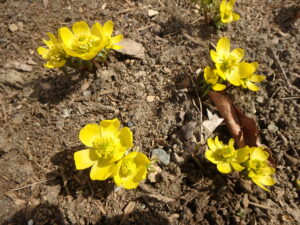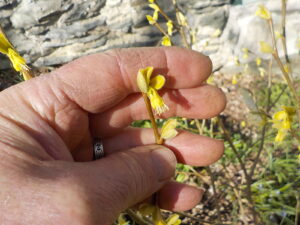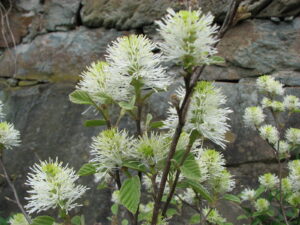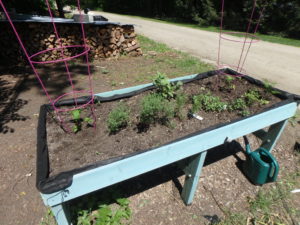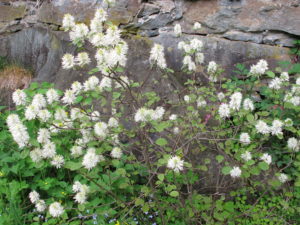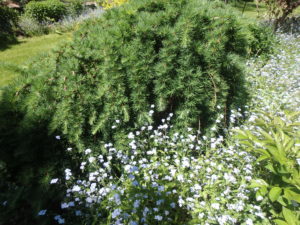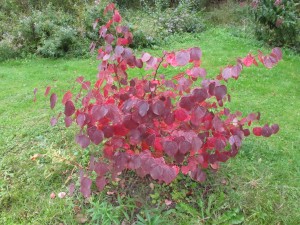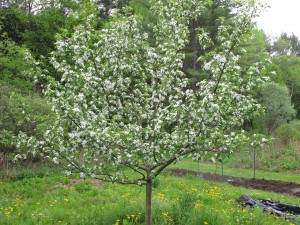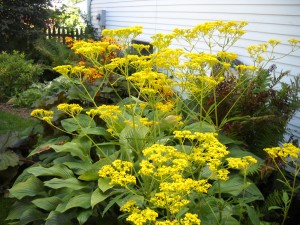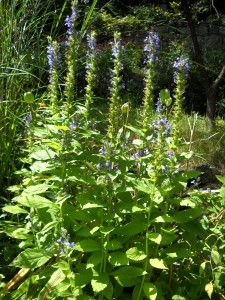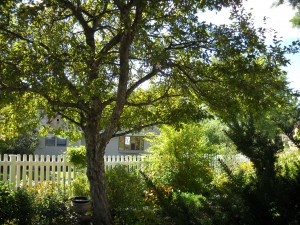Spring Flowers I Love
Spring has teased us this year: she comes, she goes; warm sunny days are followed by high winds, cold rain and even pellets of ice. But the spring flowers persist, starting with those dainty white snowdrops that appear reliably in early March for me. Let’s look at a few – bulbs, shrubs and trees. Perennials I will do on another day.
Along with those flowers come a bright yellow one, Winter Aconite (Eranthis hyemalis). These are low-growing, upward facing flowers with 5 to 8 petals (actually sepals, but who cares?). Like the others, they tend to spread and increase in number. Order some now, along with the others mentioned, and plant them in the fall.
This week my leatherwood bush (Dirca palustris) is in bloom with heart-stopping beauty. It is a small native shrub that blooms in dry shade for me. It has lovely gray bark much like beech trees and yellow blossoms that appear before the leaves. The blossoms are small and elegant, and almost seem to glow. It is not a common shrub for sale in nurseries. Mine has upward growing branches in a vase-shaped arrangement. I love it and visit every day when in bloom.
Perhaps a better shrub to choose would be a fothergilla, which is native and early. There are 2 species, Fothergilla major and F. gardenia, also known as dwarf fothergilla. It has wonderful white bottlebrush flowers in May and best of all, it has fabulous fall foliage color. Red, orange, purple and yellow leaves on one plant! It is not a fast growing plant, and rarely needs pruning.
Gardening As We Get Older
I reached the age of 72 recently and have been thinking about the future. What will my gardens be like when I’m 82? Will I be gardening at 92? I realize I won’t always have the strength, stamina and energy to manage all I do now. Here are some thoughts about how I shall cope – and my ideas about what to do, starting now.
First, I’ll need to make choices about what flower and vegetable beds I want to keep. Growing lawn is the easiest of all gardening activities. I can see myself riding around on a mower when I can’t bend over easily to weed. And there are plenty of people who will cut the grass for a price. No special knowledge about plants is needed.
So at some point, I can let some beds revert to lawn. There are plenty of people who would be glad to come dig up and take away peonies or delphinium. If I put an announcement in the town list serve, I will find takers. Last fall I dug up some big clumps of phlox and offered them free and I found homes easily. When I want to downsize, I will make the takers do the digging!
Right now I grow 35 to 50 tomato plants a year. I start them indoors, plant them, tie them to tomato cages, cut off diseased leaves, and harvest them. Do I really need so many? We have plenty of good growers in the region, and a number of great food co-ops. I suppose in 10 years I could downsize to a dozen plants or less.
For two summers I’ve had a garden trug, a planting box on legs that I got from Gardeners Supply Company (www.gardeners.com). I have it near the front door, next to the woodpile, with quick access to the kitchen. I grow one or two tomato plants each summer there, along with plenty of lettuce and herbs. It’s waist high, so no bending is required. It’s made of cedar, and I can see using it in perpetuity. It is 6 feet long by 32 inches wide, and 16 inches deep in the middle – fine for tomatoes.
Shrubs are less work to maintain than perennials or annual flowers. Plant them, or have someone plant them, and they will require little – so long as they are not varieties that grow inordinately fast. There are plenty that can go several years without pruning.
One of my favorites is called fothergilla (Fothergilla major). It has nice white bottle-brush blossoms in May and spectacular fall foliage. Mine, after 15 years and very little pruning, is only 5 or 6 feet tall and wide. It’s hardy to Zone 4.I love my weeping larch tree (Larix laricina ‘Pendula’) that grows in a flower bed. Weepers flow and bend, but do not get tall. Mine will never get more than 3 feet tall. The foliage is soft to the touch. Larches do well in wet soils, and are quite salt tolerant.
There are, in fact, dozens of trees and shrubs sold as miniatures. Some of these are just very slow growing (like the lilac ‘Miss Kim, which can get large), while others really will never get tall, even in 25 years. These miniatures do well in flower beds.
Purple foliage is great to add color to a flower bed but I wouldn’t recommend common ninebark (Physocarpus opulifolius) ‘Diablo’ – it grows too fast and gets to be 10 feet tall before you know it. Now there are a couple of miniatures on the market, ‘Tiny Wine’ and ‘Little Devil’. I shall try one or both of those.
Of course, as we get older, it makes sense to hire some help in the garden. I have been lucky to get a teenager who not only likes being outdoors, but likes gardening and knows the difference between a weed and a flower! Even 4 hours a week makes a big difference.
If you can’t afford to have someone helping all summer, perhaps you can get someone to help clean up the gardens in spring and fall. Once beds are weeded out and mulched, the work of maintaining a garden is not too onerous – even for geezers.
I recently re-read Gardening for a Lifetime: How to Garden Wiser as You Grow Older by Sydney Eddison. Sydney is a friend of mine who lives in Connecticut, and has written many fine books. She has lots of good ideas, including the necessity to accept imperfections in the garden.
Many good gardeners are perfectionists. But as we get older, we have to accept that we can’t keep the garden perfect, or at least not without lots of help. It’s important to change one’s attitude as one ages.
Sydney also recommends getting rid of high maintenance plants and letting easy plants dominate. Daylilies, for example, have nice foliage all summer, great blossoms, and are not overly ambitious (Most don’t try to take over space allocated for other plants.) So grow plenty!
As we get older, so do our trees, creating more shade. Embrace shaded areas as weeds are sun-lovers and there are plenty of fine perennials that will do well in shade.
Some day perhaps I’ll retire and have more time for gardening. In the meantime, I’ll just try to downsize a little every year.
Follow Henry’s blog posts at https://dailyuv.com/
Fall Color
Some years ago, in a moment of enlightenment, the New Hampshire legislature outlawed the propagation, transport and sale of three popular landscape plants: burning bush, barberry, and Norway maple. All three had been proven to be invasive, seeding into the woods and crowding out our native plants. Both Massachusetts and Connecticut have banned them, too, but so far Vermont, Maine and Rhode Island have not.
I agree with the ban. All three are thugs. Even where banned, the plant police will not come and take away your invasive plants, although I do recommend that you pull yours and replace them. I also understand why so many people love burning bush (Euonymus alatus), especially now when it displays brilliant red foliage. It will grow anywhere and stays a nice size.
There are good alternatives to burning bush that will provide good – even spectacular – fall color. The best I can recommend is fothergilla (Fothergilla spp.). This is a small to medium sized shrub with gorgeous white bottlebrush flowers in April and brilliant leaves starting now. It is slow growing, so it need not be pruned often, which I consider an advantage. The fall foliage can range from red and purple to yellow and orange – and I’ve had all 4 colors on one plant. A named variety, ‘Mt Airy’, is one of the best.
The common blueberry is another nice shrub that has red and yellow leaves in fall. The white blossoms in June are nice – and who knows, you might even beat the birds to a few berries. The trick to success with the berries is to get the soil very acidic by adding garden sulfur to the soil, or, right after flowering, add an acid fertilizer like Holly-Tone or Pro-Holly. But don’t add fertilizers now – you don’t want any soft new growth just before the winter.
Another great plant for fall color is redbud hazel (Disanthus cercidifolius). It is not commonly found in garden centers, but I predict it will be: the leaves turn a brilliant claret red to purple early in the autumn. I got one last year and it suffered from the cold winter with some branches dying back. It also was munched by deer. But it rebounded nicely this summer, and is putting on a great show. According to Professor Michael Dirr’s books, it might reach 6 to 10 feet tall, and does well in partial shade and moist, rich soil. Dirr says it is hardy to minus 20, and we saw temperatures colder than that last winter, so I should be glad mine survived.
Spirea is the common (and scientific) name for a group of shrubs commonly planted around post offices and municipal buildings. It is what I think of as an “urban survivor”. Like that banned burning bush, it requires little and will survive almost any conditions. There are some varieties that have excellent fall color. ‘Glow Flame’ and ‘Glow Girl’ are varieties with good red color that I have seen, though, not grown.
Some azaleas also develop good red colors. ‘Cornell Pink’ is a very early- blooming azalea that also has excellent red leaves right now – in some places, but not others. I saw two examples growing side-by-side. One had a nice burnt red color, the other had leaves that were still an ordinary green. Beats me why one should turn color, the other not.
Both the double file viburnum (Viburnum plicatum) and arrowwood viburnum (Viburnum dentatum) often have excellent red fall color. But like the azaleas mentioned above, there is limited consistency. If you want to get a specimen that shows good color, buy one with good color at the nursery and plant it now. Both produce nice white flowers in the spring and produce berries in late summer that are relished by birds. They are medium-sized shrubs that are pleasant additions to the landscape.
One word of warning: there is a viburnum leaf beetle, a foreign pest, that has recently appeared in the landscape and it can devour the leaves of viburnums and ruin their appearance – or even kill them. I’ve been told that this new pest came down from Montreal, so some northern gardens have been affected before those in southern locations.
One last suggestions to consider is the red chokeberry (Aronia arbutifolia. I bought one 10 years ago after reading about this species and seeing a specimen with brilliant foliage. What struck me was that the tops of the leaves in fall were red and the undersides were silver. But my specimen has not thrived, and I have moved it once on my property trying to find just the right place for it. It is generally said to be adaptable to soils and sun conditions, and the berries are so bitter that even the birds will not eat them. Still, it’s worth a look. My specimen has stayed about 6 feet tall.
As with anything we do in the garden, there are few guarantees when it comes to fall color. Burning bush? Yes. Red, year after year. And I’ve always been pleased with fothergilla. But even our favorite maples cannot be depended on to put on a spectacular show every year. So please don’t sue me if you pull out your burning bush and plant a spirea or a viburnum and it doesn’t perform as well! Each shrub we plant has its virtues.
Henry Homeyer is the author of 4 gardening books and is a UNH master Gardener. His web site is www.Gardening-Guy.com/.
Selecting and Training Flowering Trees
This has been a great year for flowering trees and shrubs. My Merrill magnolia had many hundreds of white blossoms in late April.
The crabapples everywhere put on a spectacular display this year. My fothergilla (a shrub with great fall leaf color) is in bloom now with its tidy white bottle-brush flowers. My ‘Olga Mezitt’ rhododendron (one of the parents of the popular PJM rhodie) is looking great and my wild azaleas are getting ready to bloom. And now the lilacs are blooming for me and I am overwhelmed with the large purple, blue, white and pink panicles (clusters of flowers). Spring has definitely sprung.
All these blooms this year will certainly encourage many gardeners to buy trees and shrubs and plant them. That’s a fine idea, but if you plant now, please remember that you must keep watering them all summer if we don’t get an inch or more of rain per week. When August comes around it will be easy to have your new tree dehydrate if you get lazy or forgetful.
New trees and shrubs need a year or more to grow roots sufficient for their needs if we get hot, dry weather. So if you are forgetful or will be doing lots of traveling, you might want to hold off on planting a new tree until fall, which is also a good time for planting. Fall is cooler and more likely to be rainy.
I like to buy flowering trees and shrubs when they’re in bloom. That allows me to see the color and check out the fragrance. But there is more than just the flowers to consider when selecting a good crabapple or magnolia. Let’s start with size and price. Bigger
is not necessarily better. If you are on life support and don’t expect to be around in 5 years, sure, buy the biggest tree you can afford. But be aware that a bigger tree is not only more expensive – it is also harder to plant and takes more water and care. A bigger tree may have a smaller proportion of its root system intact after being dug up and put in a pot than a small tree. I like to buy smaller specimens and then train them to be a nice shape. That’s harder to do on a larger tree.
I recently visited a nice new nursery run by Henderson’s Tree Service on Rte 14 in Hartford, Vermont. There I chatted with my friend Sylvia Provost who is co-owner of the business. I asked Sylvia what she would look for if purchasing a crabapple for herself. Without a moment’s hesitation she responded. “Structure,” she said.
What Sylvia was talking about is the shape of the tree and the placement of the branches. Fruit trees produce best on branches that leave the trunk at a right angle or are aiming just slightly upward. Branches that shoot straight up are not usually good fruit and blossom producers.
And although Sylvia noted that you can train a tree to be the shape you want, it is easier to start with something that is closer to your ideal before you start training. So, for example, Sylvia said that if you have a swimming pool some distance from your patio, you should choose a tree that has an open format, one that you can see through – and see what is happening at the pool. Conversely, if you have nosy neighbors and want to screen their view of your patio, you might select a tree that has a full, dense arrangement of branches.
Generally, pruning a tree should begin in the second year of its life at your home. I often see apple and crabapple trees that have very low branches. I like to prune off those low branches to make it easy to mow around, and to have a nicer look. And if two branches are both striving to be the “leader” or the dominant, tallest stem, I remove one. And although most books say you should prune fruit trees in March or April, you can safely make a few judicious cuts now to train your tree.
You may train branches to grow at different angles by weighing them down – if you do so soon. This is an activity for spring, starting before the new layer of cambium growth has occurred. You can drive a stake into the ground and tie a branch to it for the next 2 months. A branch the diameter of a finger can weighed down by hanging a plastic pop bottle on it, then filling it with water until it bends to the correct angle.
Chris Wilson of the EC Brown Nursery in Thetford, Vermont suggested that when buying a tree, look at leaf color – leaves should be green, not tinged with yellow. He also suggested making sure the tree has branches on all sides, and that the bark has not been damaged.
So if you’ve delighted in the flowers on trees in your neighborhood this year, go get one or more. Study several specimens to find the best one. And just remember to water all summer long!
Henry Homeyer is a gardener and garden designer living in Cornish flat, NH. His Web site is www.Gardening-Guy.com.




